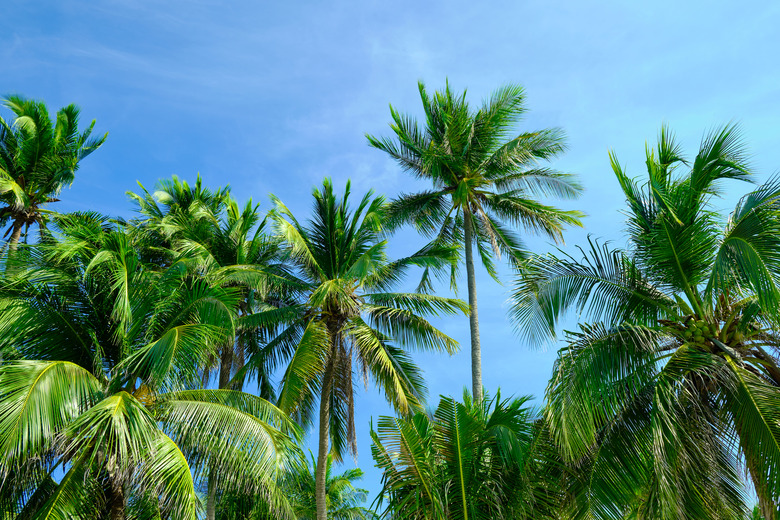The Differences Between Palm Trees And Palmetto Trees
We may receive a commission on purchases made from links.
While they are all members of the Arecaceae family, palmettos and palms are not the same plants. Only a few palm trees such as the Everglades palm (Acoelorraphe wrightii, USDA zones 9-12), Florida silver palm (Coccothrinax argentata, zones 10-11) and desert palm (Washingtonia filifera, zones 9-11), also called California fan palm, are native to the United States. Several palmetto species grow wild in a band from Texas and Oklahoma eastward to the Carolinas, Georgia and Florida. Palms and palmettos generally grow best in tropical and subtropical climates.
Palmetto and Palm Tree Sizes
Palmetto and Palm Tree Sizes
The main difference between palmettos and palms is tree size. Palms can top 80 feet tall, while the largest palmetto grows only about 30 feet tall. Both palm trees and palmettos are monocots, which means they do not produce trunks or main stems in layers the way oaks, pines and other woody trees do. Palm trees have no bark. Palm trees grow their stems underground for the first few years and the plant remains quite short.
When the tree finally sends its stem upward, the real show begins, because palms can add as much as a foot of height every year. While a pygmy date palm (Phoenix roebelenii, zones 10-11) is only about 12 feet tall, the native royal palm (Roystonea spp., zones 10-11) can get up to 80 feet tall. Cabbage palm (Sabal palmetto, zones 7b-11) is one species of palmetto that grows upright to about 30 feet tall.
Palm tree trunks grow vertically, while the main stem of most palmetto species generally stay on or just below the ground and grow horizontally. Dwarf palmetto (Sabal minor, zones 7-10) grows 2 to 7 feet tall while saw palmetto (Serenoa repens, zones 8-11) is 5 to 10 feet tall. Scrub palmetto (Sabal etonia, zones 8-11) is only about 4 feet tall at maturity. Cabbage palm (Sabal palmetto, zones 7b-11) is a tall species of palmetto that grows upright to about 30 feet.
Palm and Palmetto Foliage
Palm and Palmetto Foliage
Palms produce large fronds in an alternate or spiral pattern. The leaves have parallel veins and grow 18 to 36 inches long. Most, but not all, palmettos have thick, flattened leaves in a star shape that may exceed 36 inches in length. The saw palmetto has lancelike, stiff leaves in a star-shaped pattern. The leaves have small serrations, which gives the plant its common name.
Flowers on Palms and Palmettos
Flowers on Palms and Palmettos
Desert, royal and queen palms have showy white flowers. Royal palm's highly aromatic flowers are yellow, while the others can be white, cream or gray. Scrub palmetto produces small, uninteresting white flowers, but saw palmetto proudly displays its fragrant, yellowish white flowers on stalks up to 3 feet long. Dwarf palmetto is more demure, sending its flower stalks out to just beyond the tips of the foliage to display its fragrant white flowers.
Palmetto and Palm Tree Fruits
Palmetto and Palm Tree Fruits
Queen palm produces bright orange, ornamental dates. The large, heavy fruit of coconut palm (Cocos nucifera, zones 10-11) falls from the tree when ripe and can damage property or injure anyone standing under the tree when they fall. Palmettos produce small, berrylike fruit less than an inch long that birds find delicious.
References
- Lady Bird Johnson Wildflower Center: Everglades Palm
- Lady Bird Johnson Wildflower Center: Florida Silver Palm
- Lady Bird Johnson Wildflower Center: Desert Palm
- University of Florida: Phoenix roebelenii: Pygmy Date Palm
- University of Florida; Roystonea regia: Royal Palm
- University of Florida: Sabal palmetto: Sabal or Cabbage Palm
